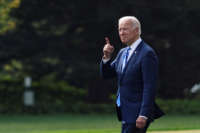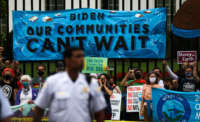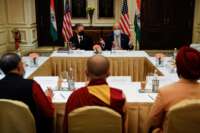
Armando Alejo Hernández went missing in the desert after crossing the U.S.-Mexico border in May of 2021, but not before sending several last audio messages to his eldest son describing the difficult terrain and asking for help. “He wasn’t feeling so good, and he was out of water and food,” says Hernández’s 17-year-old son Derek. “The group got ahead, and then he lost the group.” Hernández was an undocumented worker in the United States for more than a decade before being deported in 2016. His wife and two sons, who are U.S citizens by birth, have pleaded with Border Patrol and the Mexican Consulate for help, without any luck so far. “This year we are going to break the record of migrants dying at the border,” warns Fernando García of the El Paso-based Border Network for Human Rights, one of many organizations demanding that the Biden administration “fulfill their promise to change the inhumane policies at the border.”
TRANSCRIPT
AMY GOODMAN: The West Texas town of Van Horn is in the news today as the site of the scheduled private space flight launched by Blue Origin, the company started by Amazon founder Jeff Bezos, one of the world’s richest men. Passengers will include the 90-year-old actor William Shatner, best known for playing Captain Kirk on Star Trek. Shatner and three others will be rocketed high above the unforgiving Chihuahuan Desert that straddles the U.S.-Mexico border. For these giddy space tourists experiencing weightlessness, it may be the trip of a lifetime, but far below, countless others make a far weightier trip, attempting the perilous trek from Mexico across the desert furnace on foot, seeking refuge in the United States. Many of these migrants, exhausted and dehydrated, perish in the desolate terrain.
We begin today looking at the tragic story of the father of two boys. He crossed the Texas-Mexico border with hopes of reuniting with his family in Utah. He was last heard from in early May as he tried to walk across the Texas desert on foot. For more than a decade, Armando Alejo Hernández was one of more than 12 million undocumented residents in the United States. He was deported in 2016, leaving behind a family in Park City, Utah, including his two sons, now 13 and 17. They’re both U.S. citizens by birth.
After spending five formative years without his father, his elder son Derek asked his dad if he could visit them in the United States. Armando promised he would find a way. Little is known about Armando’s trek across the border and through the desert, but he did make calls to Derek and leave some voice messages. In one call, Armando told Derek he was out of water, that his cellphone was almost dead, that he didn’t think he could go on. In another message, Armando described the clothing that he was wearing.
ARMANDO ALEJO HERNÁNDEZ: [translated] I’d arrive in about three hours. I’m wearing a black Jordan sweatshirt and blue pants.
AMY GOODMAN: Armando also described the harsh terrain in the Texas desert.
ARMANDO ALEJO HERNÁNDEZ: [translated] I don’t think I can make it all the way up there. It’s all the way up the peak, son, all the way up the hill.
AMY GOODMAN: These messages were the last time Armando’s family heard his voice. Based on a photo Armando sent his family, it appears he was in Hudspeth County, southeast of El Paso near Eagle Peak, where the U.S. government has a radar installation. Armando was never heard from again.
In a moment we’ll be joined by his son Derek, but first I want to turn to Armando’s brother, Marcos Alejo. He’s a restaurant worker in Park City, Utah. He and Armando first migrated to the United States together in 2000. Marcos last spoke to Armando in early May, just before he went missing in the desert.
MARCOS ALEJO: [translated] We are searching for Armando. He’s been missing for five months now. He was coming to the United States to help his child, who asked for support with school. He came here to work. He’s a very honest and hard-working person.
We were asking for the support of Border Patrol. Then we asked the Mexican Consulate for support. And they would say yes, but we never saw any action. I would call them every eight days, and they would tell me they were looking for him, but we didn’t have any luck.
My brother is a very kind person, and it would mean the world to us if he returned. This entire family, we’re all so worried because it’s been five months. We want to see him. We want to hug him, but we, sadly, can’t. I don’t know what’s going on. My brother is a very calm person. He came here so excited to work and help out his two children. My family in Mexico is so worried. My mother is ill. We hope we have a miracle soon.
I’ve been fighting, trying to find him through other agencies. I’ve called the Catholic churches in Texas, and I don’t have any answers. I’ve called the morgue. All they tell me is “You just have to wait. You just have to wait.” And that’s what we’ve done for the past five months, and we’ve heard nothing.
AMY GOODMAN: That’s Marcos Alejo speaking to Democracy Now! about his brother Armando, who went missing in the Texas desert in early May.
We’re joined now by two guests. Fernando García is with us. He’s founder and executive director of the El Paso, Texas-based Border Network for Human Rights. He’s in Los Angeles now. And with us from Park City, Utah, is Armando’s 17-year-old son, Derek Alejo Barrios. Derek was the last person to speak to Armando before he went missing.
Hi, Derek. Thank you so much for joining us. We heard those painful last clips of your dad, the WhatsApp messages that he left you. Can you talk about what you understood about his journey?
DEREK ALEJO BARRIOS: What I understood was that he took a longer route. It was a longer route, but it was easier, instead of running into the immigration right away, so he took that route instead. And the day before he called me, he said that everything seemed like it was going as planned. But the very next day is when he called me that he got into some trouble and that he wasn’t feeling so good and that he was out of water and food. And then, that’s where the trouble started. And he asked me to find any help, even if it was Border Patrol and he would have to go back to jail for that. So, he wasn’t afraid to go back, but he was wanting help from someone to at least rescue him so he wouldn’t be stranded out in the desert.
JUAN GONZÁLEZ: Yeah, and, Derek, at the time that he called you, was he traveling by himself, or had he started out with a group of people at first? Can you talk about that at all?
DEREK ALEJO BARRIOS: He started out with a group of people. And as they kept going, my dad wasn’t feeling good, and he was slowing down. So, he didn’t want to slow down the rest of the group, so they wouldn’t get endangered or just get in trouble by immigration. So, what he decided to do was just stay behind and let them go on, because he couldn’t keep on. So, that’s where he started slowing down and just taking breaks, and the group got ahead, and then he lost the group.
AMY GOODMAN: I want to turn to a person who was with him on that journey, and then we’re going to bring Fernando García into this conversation. Telemundo El Paso spoke to one of seven migrants who crossed with Armando and last saw him before he was left near Sierra Blanca, Texas. Alexis Corona told Telemundo the temperature on that day in May was likely above 100 degrees Fahrenheit.
ALEXIS CORONA: [translated] Armando said he couldn’t walk anymore, and he wanted to see if he could be rescued. … From where he stayed, maybe eight or nine miles ahead, the rest of us were caught by immigration agents. And we explained to them where Armando was, that he couldn’t walk anymore, that he didn’t have enough water or food. And the reaction was, “Oh, OK, well, if he stayed behind, he’ll just have to stay there.”
AMY GOODMAN: So, that was Alexis Corona, who was arrested and deported, saying that he told the immigration authorities that a man, Armando Alejo Hernández, had been left behind. This is where I want to bring in Fernando García, head of the Border Network for Human Rights. Can you talk about this situation, that you’ve been following for some time now? At this point, again, we have not heard from Armando since the first week in May, when he left those messages for his son and talked to his brother. Yet you have this migrant saying he told the immigration authorities that a sick migrant was left behind, and told them where he was.
FERNANDO GARCÍA: Amy, Juan, good morning. Again, thanks for having me.
I mean, this is a very important issue, and it’s long overdue to talk about this human rights crisis at the border. Unfortunately, Armando’s case, it is not a single case, an isolated case. This is part of a very dramatic pattern, brutal strategy towards immigrants and refugees at the border. Just to give you an example, since 1995, more than 500 migrants have died every year while crossing the border. Many of them are never found. Many of them are still disappeared. The families are still waiting for them, looking for them, as in this case.
It is a very intentional policy that was implemented back then in the ’90s, that was called “prevention through deterrence.” The idea was that immigrants will find very hard to cross the border if they are pushed into the deserts and into the mountains. So, it would be very dangerous for them to cross, that they actually would be injured or, in some cases, even die, so they would be deterred from crossing. That was the intention of the policy. Well, what happened is that migration didn’t stop. And this policy is and this strategy is still in place since then, so thousands and thousands of refugees, asylum seekers actually have died, and many of them have not been found. So, it is a failed strategy. It has caused a lot of damage and a lot of suffering.
Like, in this case, we actually got specifically involved by calling Border Patrol and calling the Mexican Consulate. And again, even that protocol had failed. I mean, they had — it seems that they didn’t do anything, even though they had all of the information about Armando, Armando’s pictures, the recording that you have, the statement of the families. And up to date, neither the Mexican Consulate and the Border Patrol have done anything. They have not produced a single report on Armando’s case. So, this is very unfortunate, but I think the fact that we’re talking about it today, we hope that this is going to bring more attention to the issue.
JUAN GONZÁLEZ: And, Fernando, in terms of the role of the Border Patrol in this situation, are they generally — what have you seen in terms of their willingness to try to search for some of these lost people? I mean, we’ve had segments here on Democracy Now! of the Border Patrol actually going after organizations that try to provide water and other food supplies for migrants crossing the desert. What’s your sense of how the Border Patrol deals with these issues?
FERNANDO GARCÍA: You know, we learned more about it, I mean, as we contacted Border Patrol in Armando’s case, is that it seems that they had in a strategy that they’re supposed to have a protocol for search-and-rescue operations, that they’re supposed to go, if they have enough information, to go and do search and do rescue people that is in the desert. Actually, Border Patrol publicized that. This is part of their PR, that actually they have these teams going into the deserts or in the river to actually rescue people.
But in this case, that protocol failed. I mean, what I’m saying is that there’s something that is being said publicly by Border Patrol, but, in practice, as we actually reach out to Border Patrol directly, they continue to tell us not to go to Border Patrol directly, not to report to Border Patrol Armando’s case, that we needed to go through the Mexican Consulate. As we did that, we called the Mexican Consulate, because that’s supposed to be the formal entity that would do this request for search and rescue. As we did that, they passed, and no action was taken — none of them — not a single action by Border Patrol, much less by the Mexican Consulate, so — in El Paso, specifically. So, days passed, weeks passed, and no rescue operations.
Later on, we knew also that Border Patrol do not search for remains. That means that if, after a period of time, they don’t do anything to rescue somebody, they would not do anything else. So, my impression and my feeling is that there’s a lot of people disappeared in the deserts and in the mountains, that they are not being looked for. And there’s no clear protocol by CBP and DHS.
AMY GOODMAN: You know, we have been following this case for some time, and we got a note from the chief of Texas Rescue Patrol, a division of Texas Recreational Safety and Land Management. It was very hopeful. It was in July. And it said, “I just want to follow up with you. I spoke to Lieutenant Henshaw with Hudspeth County Sheriff’s Office. Our volunteers and the Sheriff’s Office are going to conduct a joint search and recovery operation next week. We’re going to bring out our canine cadaver dogs to assist us. I can’t promise we’ll find him, but I can promise that we’ll try our best to help bring closure to this family. God bless.” But then we were told, Fernando, that that had been called off. So there was a whole plan to go out to find, perhaps, God forbid, the body of Armando, but then that was called off by the higher-ups. It was devastating to me, writing to Derek and his mother that there was this hope but then that they had said no.
FERNANDO GARCÍA: You know, let me actually point out a couple of things. In the Telemundo reference you made about this person that was traveling along with Armando, in that interview, this survivor mentioned that Armando stayed behind, like a few miles back, and the response that he got from a Border Patrol agent is that, essentially, he didn’t care. I mean that the Border Patrol did not care. So I think you have a practice of disregarding the well-being and the lives of refugees and immigrants at the border.
And this is not new. I mean, we know that there’s this sense of racism, this infusion of white supremacy and hate and xenophobia in our border policies. But I think this has transpired to the institutions at the border. I mean, there’s a point where even bodies being found at the river, they are despicably called “floaters.” They are not being recognized as human beings, people that are looking for a better life and trying to cross the border to be with their families, as in this case with Armando’s family. So I do believe there is an intentional dehumanization of immigrants and refugees. And why that is intentional? Because if we really are concerned, if America is concerned about lives and about human beings, we could not understand how many thousands of migrants have died at the border.
This is a human rights crisis. It is imperative that something is done. And it’s imperative that this administration, that promised a new approach for immigration and for the border, they need to stop this madness at the border. They need to stop this aggression. So many people has been suffering. So many families are being impacted by migrants dying at the border, as in this case.
JUAN GONZÁLEZ: And I wanted to ask you — you had mentioned this administration. It’s continuing President Trump’s policies in relationship to the Title 42 program. It’s exploiting — which exploits an obscure section of U.S. health law that allows deportation without any kind of due process during a public health crisis, as we have with the COVID pandemic. I’m wondering your sense of what the Biden administration is doing right now.
FERNANDO GARCÍA: You know, you’re correct. You’re right. I mean, everybody knows, at the border, but in the nation, that Title 42 was an anti-immigrant strategy, an anti-immigrant policy implemented by Trump. So, we did not — we do not understand how President Biden, this new administration, has not repealed and stopped this.
What it essentially does is it stops — Border Patrol stops people while crossing the border and immediately expels them, without due process, with no possibility, in many cases, to apply for asylum or refugee status. So people is being expelled rapidly. So, that situation, in the last few years, has created a very dangerous situation at the border.
Actually, I believe that this year, maybe, maybe we’re going to break the records of migrants dying at the border and people disappeared at the border, because of Title 42, specifically Title 42. So, there is a push by organizations, by the immigrant rights community to ask this administration to fulfill the promise to change the inhumane policy at the border, starting by Title 42.
AMY GOODMAN: And you met with Vice President Kamala Harris on the border, Fernando. What did she say about this? You have, for example, a top-level State Department official, under Obama and under Biden, Harold Koh, formerly a Yale professor, quitting over Title 42.
FERNANDO GARCÍA: I think it is difficult to understand why things are not changed, but I think what has transpired is that the Biden administration and everybody in this administration, they have a good narrative about the border and about immigration generally. I mean, it seems that they had good intentions in humanizing immigrants, in passing immigration reforms, on rebuilding the asylum and refugee process at the border. But in practice, in the field, little things changed. I mean, I think one is the narrative, but also there’s strategies happening at the border. We still have children in detention. We still have refugees in military bases. And also we have a lot of people dying because of these policies. So, I think that change that was promised has not come to us as rapidly. So, I think there is still time for this. I mean, the administration still has time to correct, to correct these wrongs at the border, to actually fulfill the promise and repeal Title 42.
AMY GOODMAN: We want to end with Derek, and, Fernando, if you have something you’d like to say to Derek. Derek, you’re in high school. It’s right before you’re going to school now. You’re 17. When are you turning 18?
DEREK ALEJO BARRIOS: I turn 18 on the 24th of this month.
AMY GOODMAN: Oh. Well, the very, very best for your birthday. I’m only hoping the best for your family.
DEREK ALEJO BARRIOS: Thank you.
AMY GOODMAN: Can you talk about why you wanted your dad back in Park City?
DEREK ALEJO BARRIOS: I wanted him back here because it’s just tough not being able to see my dad, and the only form of communication we had was just calling over the phone or sometimes FaceTiming. And it’s just tough, because I was just really close with my dad. And — sorry — and just not having him around was kind of tough on me, because I grew up, pretty much my whole childhood, like my younger age, when I was younger, all the time with my dad. And just not having him around was tough. And so, we were on the phone one day, and I asked him if he could come back, because I just wanted him around. And the last time I got to see him in person was in 2019. And before that, I didn’t get to see him for four years. So, it was just really hard on me, so that’s why I asked him to come back. And he said he would. And then, that — when he tried, all of that happened. So, it was really unfortunate, and it’s just a tough situation to go through.
AMY GOODMAN: I want to show that picture again that your dad, Armando, took, not of himself, but of what was ahead of him in Hudspeth County in the harsh desert. And he circled that white radio tower that was in front of him. For anyone in the Hudspeth County area, you could figure out — certainly CBP knows it like the back of their hand — where Armando was at that point. Fernando, any last words for Derek?
FERNANDO GARCÍA: Yeah. Derek, I’m so sorry that this is happening. Please know that we are not going to stop looking for your dad. That’s the promise of the Border Network. And I believe that also Amy is committed to actually bring a little bit this case up and actually show it out to the nation, because what is happening to you and to your family shouldn’t be acceptable. So, we will not stop, and we’re going to continue looking for your dad.
DEREK ALEJO BARRIOS: Thank you very much.
AMY GOODMAN: Derek, thank you so much for being with us. It’s very brave just to come on this television and radio show. Derek Alejo, 17 years old, in high school, a senior, wanted his dad to be at his graduation. His dad is Armando Alejo Hernández. He is 40 years old. Fernando García, we want to thank you for being with us, head of the Border Network for Human Rights, which is based in El Paso, Texas.
And we’re staying on this broader issue. When we come back from break, we’re going to speak to the director of the South Texas Human Rights Center and look at the new documentary, Missing in Brooks County. Stay with us.
This post was originally published on Latest – Truthout.














